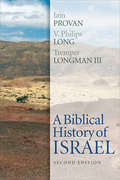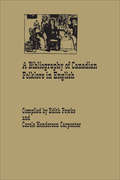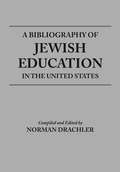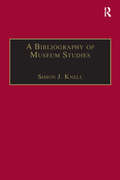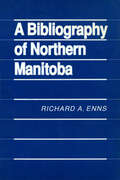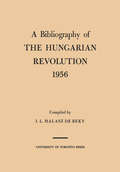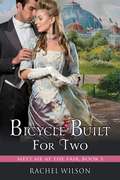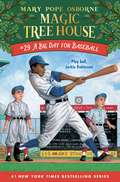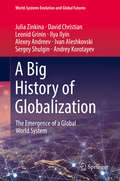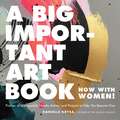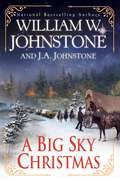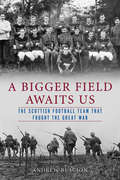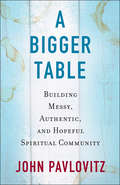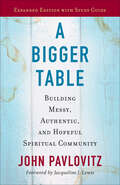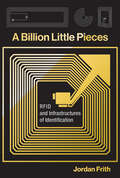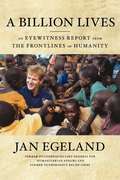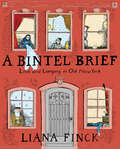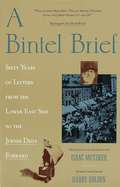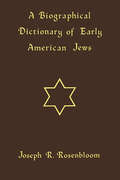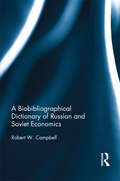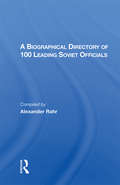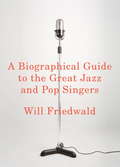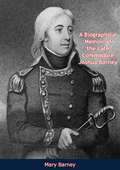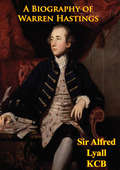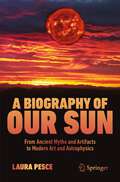- Table View
- List View
A Biblical History of Israel
by Tremper Longman III Iain Provan V. Philips LongFor over a decade, A Biblical History of Israel has gathered praise and criticism for its unapologetic approach to reconstructing the historical landscape of ancient Israel through a biblical lens. In this much-anticipated second edition, the authors reassert that the Old Testament should be taken seriously as a historical document alongside other literary and archaeological sources. <p><p> Significantly revised and updated, A Biblical History of Israel, Second Edition includes the authors' direct response to critics. In part 1, the authors review scholarly approaches to the historiography of ancient Israel and negate arguments against using the Bible as a primary source. In part 2, they outline a history of ancient Israel from 2000 to 400 BCE by integrating both biblical and extrabiblical sources. The second edition includes updated archaeological data and new references. The text also provides seven maps and fourteen tables as useful references for students.
A Bibliography of Canadian Folklore in English
by Edith Fowke Carole Henderson-CarpenterThis book is the only comprehensive bibliography of Canadian folklore in English. The 3877 different items are arranged by genres: folktales; folk music and dance; folk speech and naming; superstitions, popular beliefs, folk medicine, and the supernatural; folk life and customs; folk art and material culture; and within genres by ethnic groups: Anglophone and Celtic, Francophone, Indian and Inuit, and other cultural groups. The items include reference books, periodicals, articles, records, films, biographies of scholars and informants, and graduate theses. Each items is annotated through a coding that indicates whether it is academic or popular, its importance to the scholar, and whether it is suitable for young people. The introduction includes a brief survey of Canadian folklore studies, putting this work into academic and social perspective. The book covers all the important items and most minor items dealing with Canadian folklore published in English up to the end of 1979. It is concerned with legitimate Canadian folklore – whether transplanted from other countries and preserved here, or created here to reflect the culture of this country. It distinguishes between authentic folklore presented as collected and popular treatments in which the material has been rewritten by the authors. Intended primarily for scholars of folklore, international as well as Canadian, the book will also be of use to scholars in anthropology, cultural geography, oral history, and other branches of Canadian culture studies, as well as to librarians, teachers, and the general public.
A Bibliography of Jewish Education in the United States
by Norman DrachlerThis book contains entries from thousands of publications whether in English, Hebrew, Yiddish, and German—books, research reports, educational and general periodicals, synagogue histories, conference proceedings, bibliographies, and encyclopedias—on all aspects of Jewish education from pre-school through secondary education
A Bibliography of Museum Studies
by Simon J. KnellA comprehensive bibliographic reference for students and others wishing to investigate the contemporary literature on museums and collections. The references are systematically arranged into sections including collections management, communication and exhibitions, museum education, material culture, the museums profession and museum management. Compiled from the research and teaching materials of the Department of Museum Studies at the University of Leicester it provides an essential resource for anyone studying, or working in, museums. Containing more than 4,000 references, this new bibliography provides ready access to the literature whether you are developing a disaster plan or visitor survey, or studying the history of museum education.
A Bibliography of Northern Manitoba
by Richard A. EnnsMuch has been written about the history and the people of northern Manitoba, but until now this body of work has not been readily accessible to the researcher or teacher. This bibliography identifies published sources, such as books and magazine and journal articles, as well as unpublished sources that are available to the public, including academic theses and government pamphlets, reports, and studies. It includes primarily materials dealing with the area north of 53rd parallel of latitude, but it also includes material on the area east of Lake Winnipeg as far south as the 51st parallel, a region that is similar to the North. References are listed under seven topics: bibliographies and research aids; the fur trade; Aboriginal and Métis populations; exploration and travel accounts; church and mission histories; northern geography and resources; and community histories and twentieth century resource exploitation.
A Bibliography of the Hungarian Revolution, 1956
by Ivan Halasz de BekyThis bibliography is an exhaustive, objective and unique list of sources in the study of an event the historical significance of which becomes continually more apparent. The list consists of over two thousand entries from books and pamphlets, periodical articles, motion pictures and monitored broadcasts. The articles are arranged by language, and the Hungarian and Slavic book entries are provided with English translations.
A Bicycle Built for Two (Meet Me at the Fair #3)
by Rachel WilsonHootchy-kootchy Meets Rich and Snooty in the Delightfully Sweet Americana Romance, Bicycle Built for Two, from Rachel Wilson—1893 Chicago World’s Fair—Hard-working, snobbish, and overbearing, Alex English is proud of his position in the World's Fair Agricultural Forum. When one of the women working as a fortune-teller and stand-in for the dancer, Little Egypt, threatens to upset the wholesome, educational atmosphere, Alex takes umbrage.Kate Finney is working two jobs at the fair to make ends meet and to keep herself and her mother safe from her alcoholic father. But her father pursues her to the fair and then tries to kill her. Mr. Finney is just the sort of nasty element Alex wants kept away from the fair, and if that means Kate must lose her jobs, so be it.But Kate's not going without a fight!Completely vexed by Kate's response, Alex sees the smart, strong, beautiful Kate in a new light. But it takes an unsolicited act of kindness to bridge the gap between their separate worlds and ignite a fire not easily quenched.Publisher's Note: Set in a real time and place, this story is a light and humorous romance about a couple that couldn't be more mismatched. Light on sensuality, this story will be enjoyed by readers who appreciate sweet romance."A BICYCLE BUILT FOR TWO is a rollicking ride into the gay nineties and a look at life on the wrong side of the tracks. Alex is part of the rich aristocracy and quite the snob when it comes to associating with the unfortunate people of the lower classes. He has the absurd idea that the poor are simply down on their luck because they choose to be. He is exasperating and sometimes so naive that he frustrates me. Kate is an acid-tongued young woman who is rude and pushy to the extent you want to shake her out of it. When Alex's rose-colored vision of life meets Kate's everyday reality there is an explosion of fireworks. Alex is brought down to humility and Kate is brought up to the realization that there is kindness in the world. Ms. Duncan has penned a fine adventure. A BICYCLE BUILT FOR TWO is a delightful story and not to be missed!" ~Diana Risso, Romance Reviews TodayThe Meet Me at the Fair SeriesComing Up RosesJust North of BlissA Bicycle Built for Two
A Big Day for Baseball (Magic Tree House #29)
by Ag Ford Mary OsborneMeet Jackie Robinson and solve a mystery in the #1 bestselling Magic Tree House chapter book series! PLAY BALL! Jack and Annie aren’t great baseball players . . . yet! Then Morgan the librarian gives them magical baseball caps that will make them experts. They just need to wear the caps to a special ballgame in Brooklyn, New York. The magic tree house whisks them back to 1947! When they arrive, Jack and Annie find out that they will be batboys in the game—not ballplayers. What exactly does Morgan want them to learn? And what’s so special about this game? They only have nine innings to find out! Discover history, mystery, humor, and baseball in this one-of-a-kind adventure in Mary Pope Osborne’s New York Times bestselling Magic Tree House series lauded by parents and teachers as books that encourage reading. Magic Tree House books, with fiction and nonfiction titles, are perfect for parents and teachers using the Core Curriculum. With a blend of magic, adventure, history, science, danger, and cuteness, the topics range from kid pleasers (pirates, the Titanic, pandas) to curriculum perfect (rain forest, American Revolution, Abraham Lincoln) to seasonal shoo-ins (Halloween, Christmas, Thanksgiving). There is truly something for everyone here! Have more fun with Jack and Annie on the Magic Tree House website at MagicTreeHouse.com!
A Big History of Globalization: The Emergence of a Global World System (World-Systems Evolution and Global Futures)
by David Christian Leonid Grinin Andrey Korotayev Julia Zinkina Ilya Ilyin Alexey Andreev Ivan Aleshkovski Sergey ShulginThis book presents the history of globalization as a network-based story in the context of Big History. Departing from the traditional historic discourse, in which communities, cities, and states serve as the main units of analysis, the authors instead trace the historical emergence, growth, interconnection, and merging of various types of networks that have gradually encompassed the globe. They also focus on the development of certain ideas, processes, institutions, and phenomena that spread through those networks to become truly global.The book specifies five macro-periods in the history of globalization and comprehensively covers the first four, from roughly the 9th – 7th millennia BC to World War I. For each period, it identifies the most important network-related developments that facilitated (or even spurred on) such transitions and had the greatest impacts on the history of globalization.By analyzing the world system's transition to new levels of complexity and connectivity, the book provides valuable insights into the course of Big History and the evolution of human societies.
A Big Important Art Book (Now with Women): Profiles of Unstoppable Female Artists--and Projects to Help You Become One
by Danielle KrysaCelebrate 45 women artists, and gain inspiration for your own practice, with this beautiful exploration of contemporary creators from the founder of The Jealous Curator. Walk into any museum, or open any art book, and you'll probably be left wondering: where are all the women artists? A Big Important Art Book (Now with Women) offers an exciting alternative to this male-dominated art world, showcasing the work of dozens of contemporary women artists alongside creative prompts that will bring out the artist in anyone!This beautiful book energizes and empowers women, both artists and amateurs alike, by providing them with projects and galvanizing stories to ignite their creative fires. Each chapter leads with an assignment that taps into the inner artist, pushing the reader to make exciting new work and blaze her own artistic trail. Interviews, images, and stories from contemporary women artists at the top of their game provide added inspiration, and historical spotlights on art "herstory" tie in the work of pioneering women from the past. With a stunning, gift-forward package and just the right amount of pop culture-infused feminism, this book is sure to capture the imaginations of aspiring women artists.
A Big Sky Christmas
by William W. Johnstone J.A. JohnstoneOutlaws, snowstorms, rugged terrain—nothing will stop them from making it to Montana Territory in time for Christmas . . . “A masterful storyteller.” —Publishers WeeklyFrom the masters of frontier fiction comes a holiday tale set in the very heart of America—a Western saga of courageous souls coming together, with a little help from the Jensen family . . .In the fall of 1873, a wagon train of immigrants sets off from Kansas City, Missouri, bound for the Montana Territory. Leading the group is newly elected wagonmaster Jamie Ian MacCallister, a giant of a man and frontier legend who swears he can get them there by Christmas—come hell or high snow drifts . . .Plagued by brutally harsh storms and rugged terrain, outlaws and hostile Indians, the journey will be the greatest challenge these pioneers will ever face. But when things look nearly hopeless, help arrives in the form of two unlikely saviors: an old mountain man known as Preacher and legendary frontiersman Smoke Jensen. Two hard-willed men who believe in the settlers' dreams with all their hearts—and who will get them to their destination by Christmas. Even if it takes a miracle . . .
A Bigger Field wits Us: The Scottish Football Team That Fought The Great War
by Andrew BeaujonEach November, about a hundred people with paper poppies pinned to their coats gather around a memorial near a commuter rail station in Edinburgh to listen to a Salvation Army band and remember how more than a dozen members of the local football team, Heart of Midlothian—almost every member of its starting lineup and many of its backup players—went to war. The Edinburgh Evening News ran pages of splendid photos of the Hearts players in McCrae's Battalion when they enlisted in November 1914. "Clever Forwards for the Army," one headline read, but the report barely acknowledged the carnage of the Battle of the Somme that cost the battalion 80 percent of its men within a few days. On July 3, 1916, two days after the action began, the newspaper raved about its "Magnificent Opening," and mentioned only "Light Allied Casualties." The newspapers doled out news of the players' deaths slowly. After the war, surviving soldiers, many of them wounded, gassed, and suffering from what was then called "shell shock," returned home to a public that had only the weakest grasp of what had happened. Perhaps the pointlessness of so much suffering and death was too awful to contemplate. All of Edinburgh threw a parade for the men of McCrae's Battalion when they marched off to war, but no one wanted to be reminded that their commanders later traded their lives and health for a few yards of French mud.A Bigger Field Awaits Us: The Scottish Football Team That Fought the Great War tells the little-known but poignant story of a group of Scottish athletes and their fans who went to war together—and the stories of the few who made it home. The saga of McCrae's Battalion brings much-needed human scale to World War I and explains why a group of young men from a small country with almost no direct connection to the conflict would end up sacrificing their careers, their homes, their health, and in many cases their lives to an abstract cause. Their sacrifices illuminate the dark corners of this war that history's lights rarely reach.
A Bigger Table: Building Messy, Authentic, And Hopeful Spiritual Community
by John PavlovitzNo one likes to eat alone; to approach a table filled with people, only to be told that despite the open chairs there isn't room for you. The rejection stings. It leaves a mark. Yet this is exactly what the church has been saying to far too many people for far too long: "You're not welcome here. Find someplace else to sit." How can we extend unconditional welcome and acceptance in a world increasingly marked by bigotry, fear, and exclusion? <P><P>Pastor John Pavlovitz invites readers to join him on the journey to find--or build--a church that is big enough for everyone. He speaks clearly into the heart of the issues the Christian community has been earnestly wrestling with: LGBT inclusion, gender equality, racial tensions, and global concerns. A Bigger Table: Building Messy, Authentic, Hopeful Spiritual Community asks if organized Christianity can find a new way of faithfully continuing the work Jesus began two thousand years ago, where everyone gets a seat. <P><P>Pavlovitz shares moving personal stories and his careful observations as a pastor to set the table for a new, more loving conversation on these and other important matters of faith. He invites us to build the bigger table Jesus imagined, practicing radical hospitality, total authenticity, messy diversity, and agenda-free community.
A Bigger Table: Building Messy, Authentic, And Hopeful Spiritual Community
by John PavlovitzStudies show that it’s important for children to engage in educational activities even when school is out. That’s why we developed our Summer Review & Prep series. Each book includes engaging math and reading activities that review concepts from the previous year and introduce next year’s curriculum. Plus, your child will love the stickers and calendar for charting his or her progress and the colorful posters for reviewing essential skills. Each book also includes a grade-level recommended reading list.
A Billion Little Pieces: RFID and Infrastructures of Identification (Infrastructures)
by Jordan FrithHow RFID, a ubiquitous but often invisible mobile technology, identifies tens of billions of objects as they move through the world.RFID (Radio Frequency Identification) is ubiquitous but often invisible, a mobile technology used by more people more often than any flashy smartphone app. RFID systems use radio waves to communicate identifying information, transmitting data from a tag that carries data to a reader that accesses the data. RFID tags can be found in credit cards, passports, key fobs, car windshields, subway passes, consumer electronics, tunnel walls, and even human and animal bodies—identifying tens of billions of objects as they move through the world. In this book, Jordan Frith looks at RFID technology and its social impact, bringing into focus a technology that was designed not to be noticed.RFID, with its ability to collect unique information about almost any material object, has been hyped as the most important identification technology since the bar code, the linchpin of the Internet of Things—and also seen (by some evangelical Christians) as a harbinger of the end times. Frith views RFID as an infrastructure of identification that simultaneously functions as an infrastructure of communication. He uses RFID to examine such larger issues as big data, privacy, and surveillance, giving specificity to debates about societal trends. Frith describes how RFID can monitor hand washing in hospitals, change supply chain logistics, communicate wine vintages, and identify rescued pets. He offers an accessible explanation of the technology, looks at privacy concerns, and pushes back against alarmist accounts that exaggerate RFID's capabilities. The increasingly granular practices of identification enabled by RFID and other identification technologies, Frith argues, have become essential to the working of contemporary networks, reshaping the ways we use information.
A Billion Lives
by Jan EgelandCalled "the world's conscience" and one of the 100 most influential people of our time by Time magazine, Jan Egeland has been the public face of the United Nations. As Undersecretary-General for Humanitarian Affairs, he was in charge of the Office for the Coordination of Humanitarian Affairs (OCHA) for three and a half years. One of the bravest and most adventuresome figures on the international scene, Egeland takes us to the frontlines of war and chaos in Iraq, to scenes of ethnic cleansing in Darfur, to the ground zeroes of famine, earthquakes, and tsunamis. He challenges the first world to act. A Billion Lives is his on-the-ground account of his work in the most dangerous places in the world, where he has led relief efforts, negotiated truces with warlords, and intervened in what many had thought to be hopeless situations. As one of Secretary-General Kofi Annan's closest advisers, Jan Egeland was at the heart of crises during a difficult period in UN history, when the organization was plagued by the divisive aftermath of the Iraq war, the Oil-for-Food scandal, and terror attacks against UN workers. On the day Egeland came to New York to take up his job, the UN building in Baghdad was destroyed by a huge bomb, killing one of his predecessors, Sergio de Mello. Two months later Annan sent Egeland to Iraq to judge whether the UN could keep a presence there. Since that first mission to Baghdad, Egeland has been envoy to such places as Darfur, Eastern Congo, Lebanon, Gaza, Northern Israel, Northern Uganda, and Colombia. He coordinated the massive international relief efforts after the Indian Ocean tsunami and South Asian earthquake. As a negotiator and activist, Egeland is famous for direct language, whether he's addressing warlords, guerrilla leaders, generals, or heads of state. A Billion Lives is his passionate, adventure-filled eyewitness account of the catastrophes the world faces. And so Egeland writes that he has met the best and worst among us, has "confronted warlords, mass murderers, and tyrants, but [has] met many more peacemakers, relief workers, and human rights activists who risk their lives at humanity's first line of defense." In spite of the desperate need of so many, Egeland is convinced that, "For the vast majority of people, the world is getting better, that there is more peace, more people fed and educated, and fewer forced to become refugees than a generation ago. So there is reason for optimism," he concludes in this groundbreaking book that does not flinch but holds out reasons for hope.
A Bintel Brief: Love and Longing in Old New York
by Liana FinckAn evocative, elegiac love letter to New York City and the immigrant culture that continues to make it the most original and influential city in the world.As the nineteenth century gave way to the twentieth, a surge of Jewish immigrants to New York City reshaped indelibly not only the culture of the metropolis but of America itself. Struggling to assimilate to a new world while reconciling it to the old one they had left behind, these men and women shared their most private hopes and fears in a series of letters submitted to "A Bintel Brief"—Yiddish for "A Bundle of Letters"—the enormously popular, deeply affecting and often hilarious advice column of the newspaper The Forward.Conceived by Abraham Cahan, editor of The Forward, who answered every letter himself, A Bintel Brief transformed the fortunes of the paper, rapidly making it the most widely read Yiddish-language newspaper in the world. The letters that flooded into A Bintel Brief spoke with unparalleled immediacy to the daily heartbreaks and comedies of their bewildered writers' new lives, capturing the hope, isolation and confusion of assimilation, from intergenerational family politics and judgmental neighbors to crises of faith, unrequited love, runaway husbands, soul-crushing poverty and the difficulty of building an entirely new life from scratch.Drawn from these letters—selected and adapted by Liana Finck and brought to life in her singularly expressive illustrations that combine Art Spiegelman's deft emotionality and the magical spirit of Marc Chagall—A Bintel Brief is a wonderful panorama of a world and its people who, though long gone, are startlingly like ourselves. It is also a platonic love story of sorts between Abraham Cahan and Liana, as they engage in a bittersweet dialogue that explores the pleasures and perils of nostalgia, even as it affirms the necessary forward movement of life.
A Bintel Brief: Sixty Years of Letters from the Lower East Side to the Jewish Daily Forward
by Isaac MetzkerFor more than eighty years the Jewish Daily Forward's legendary advice column, "A Bintel Brief" ("a bundle of letters") dispensed shrewd, practical, and fair-minded advice to its readers. Created in 1906 to help bewildered Eastern European immigrants learn about their new country, the column also gave them a forum for seeking advice and support in the face of problems ranging from wrenching spiritual dilemmas to petty family squabbles to the sometimes hilarious predicaments that result when Old World meets New Isaac Metzker's beloved selection of these letters and responses has become for today's readers a remarkable oral record not only of the varied problems of Jewish immigrant life in America but also of the catastrophic events of the first half of our century.From the Trade Paperback edition.
A Biographical Dictionary of Early American Jews: Colonial Times Through 1800
by Joseph R. RosenbloomA remarkable reference for those interested in American Jewish history, comprising approximately four thousand names and supplemental data.Here is a near complete list of persons identifiable as Jews in America by 1800, the result of a thorough search of manuscript materials and published literature for the names of Jews who lived in America (including Canada up to 1783) during the seventeenth and eighteenth centuries.No other study provides comparable information for such an ethnic group in this country. The result of a years-long effort that began as a rabbinical thesis for the Hebrew Union College Jewish Institute of Religion and was eventually expanded, it serves as an essential reference for historians and other researchers.
A Biographical Dictionary of Russian and Soviet Economists
by Robert CampbellDespite the restrictions on their work and actions, the economists of the Soviet period produced a great deal of bold and important work. With the erosion of the old Stalinist controls, economists in the Soviet Union themselves became very interested in the history of their profession, not least in order to find authentic voices that might offer reinforcement or counterpoint to the policy analyses and recommendations with which policy makers in the transition countries are today being bombarded. This major new reference work pulls together many years of research in order to present a bio-bibliographic dictionary of Russian and Soviet economists, many of whom have previously had no coherent record compiled of their careers, achievements and wider significance. Through exploring this rich tradition of economic thought, we can go some way in understanding the role of economists in the functioning of the Soviet system, as well as bringing previously forgotten work to light, raising new questions, and providing a memorial to those who suffered as a result of the system. This hugely detailed and important new volume takes into account all the nuances of the story of Russian and Soviet economic thought, such as regional issues, the reform and transition to a market economy, and the economic output of non-economists. Featuring nearly 500 entries, and including a detailed contextual introduction, this landmark volume will be a vitally important reference work for all those with an interest in the history of economic thought, the history of economics and Russian and Soviet history more generally.
A Biographical Directory Of 100 Leading Soviet Officials
by Alexander RahrThis updated and expanded biographical directory is the first in the series of directories published by Radio Liberty since 1981 to include photographs. The volume provides detailed information about the careers and lives of current members of top Soviet party and government bodies, officials of the armed forces, and diplomats. Also represented are a number of middle-ranking officials who stand a good chance of attaining top-level posts in the next few years. Entries are in alphabetical order, and each entry includes a biographical sketch, a career chronology, a summary of the content of published articles and speeches, and details of political alignment and connections. The volume is current through summer 1990 and documents the substantial recent turnover in party organizations such as the Central Committee and in state bodies such as the newly elected Council of People's Deputies. It is an indispensable reference for scholars, business people, journalists, government officials, and others trying to follow the rapid changes taking place in the USSR.
A Biographical Guide to the Great Jazz and Pop Singers
by Will FriedwaldWill Friedwald's illuminating, opinionated essays--provocative, funny, and personal--on the lives and careers of more than three hundred singers anatomize the work of the most important jazz and popular performers of the twentieth century. From giants like Ella Fitzgerald, Louis Armstrong, Frank Sinatra, and Judy Garland to lesser-known artists like Jeri Southern and Joe Mooney, they have created a body of work that continues to please and inspire. Here is the most extensive biographical and critical survey of these singers ever written, as well as an essential guide to the Great American Songbook and those who shaped the way it has been sung. The music crosses from jazz to pop and back again, from the songs of Irving Berlin and W. C. Handy through Stephen Sondheim and beyond, bringing together straightforward jazz and pop singers (Billie Holiday, Perry Como); hybrid artists who moved among genres and combined them (Peggy Lee, Mel Tormé); the leading men and women of Broadway and Hollywood (Ethel Merman, Al Jolson); yesterday's vaudeville and radio stars (Sophie Tucker, Eddie Cantor); and today's cabaret artists and hit-makers (Diana Krall, Michael Bublé). Friedwald has also written extended pieces on the most representative artists of five significant genres that lie outside the songbook: Bessie Smith (blues), Mahalia Jackson (gospel), Hank Williams (country and western), Elvis Presley (rock 'n' roll), and Bob Dylan (folk-rock). Friedwald reconsiders the personal stories and professional successes and failures of all these artists, their songs, and their performances, appraising both the singers and their music by balancing his opinions with those of fellow musicians, listeners, and critics. This magisterial reference book--ten years in the making--will delight and inform anyone with a passion for the iconic music of America, which continues to resonate throughout our popular culture.From the Hardcover edition.
A Biographical Memoir of the Late Commodore Joshua Barney: From Autobiographical Notes And Journals In Possession Of His Family, And Other Authentic
by Mary BarneyBorn in Baltimore in 1759, Joshua Barnett embarked on his naval career in 1771 at the tender age of 12. He saw varied service around the Americas and Europe before returning to fight for the nascent United States. He arrived in America, shortly after the Battle of Bunker Hill, where he joined the colonial navy. He went on to serve aboard the sloop "War Hornet" and later other ships; distinguished at the defence of the Delaware river. He was captured and imprisoned for a short time in England. He commanded the Chesapeake Bay Flotilla during the War of 1812, culminating in his heroic efforts at the battle of Bladensburg. Six years later, in 1818, he died from the wounds he had received.
A Biography Of Warren Hastings
by Sir Alfred Lyall KcbAn important biography of the first Governor-General of Bengal and architect of the growing dominance of the British in India during the 18th and 19th centuries."The influence of Warren Hastings in laying the foundation of Britain's empire in India is second only to that of Clive. While Clive made his mark primary in the military realm, Hastings' contribution was administrative. One would typically suppose that the life of a military man would involve more danger and drama than that of an executive, but Britain's newly won realm in India was a positive snake-pit, complete with crooks, swindlers, busy-bodies, corrupt officials, corrupt natives, seething discontent, bribery, treachery, looming warfare, and rank depravity."Into this cesspool, Hastings was sent as governor-general, and for twelve years, under nearly impossible conditions, he implemented a great many reforms and fought two major wars. He left the administration of the East India Company in Bengal immeasurably better than the way he found it, and yet on his return to Britain, he was indicted for corruption by people who had no idea of the conditions he worked under. His trial lasted for seven years, nearly bankrupted him, and was largely a vehicle for sanctimonious grand-standing and political theatre. Most sane people would prefer an honorable death in combat to what Hastings endured, or, like Clive, simply blown their own head off. But Hastings endured all, and in the end was roundly vindicated.- heritage-history.com
A Biography of Our Sun: From Ancient Myths and Artifacts to Modern Art and Astrophysics
by Laura PesceThis book is for everyone curious about the Sun and how it has been perceived throughout human history, including the modern scientific view. Beginning with ancient myths and legends, superstitions, art and poetry, the book proceeds to explain the amazing composition of our star, how it produces the heat and light on which all life depends, as well as touching the harvesting of solar energy that is becoming so essential in the modern world. The book is illustrated by the author's own artwork and includes first-hand scientific information provided in interviews with professional astrophysicists.
